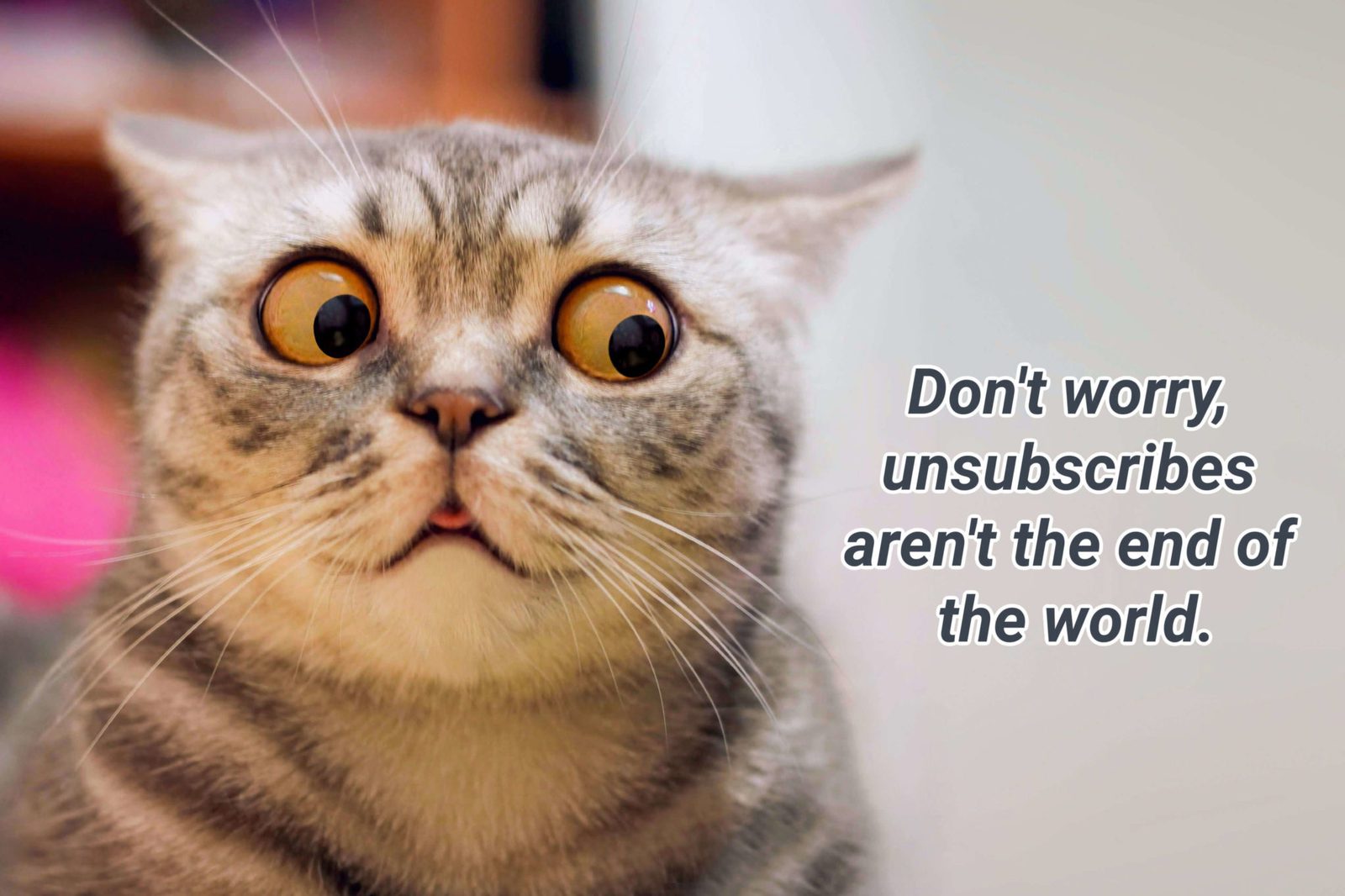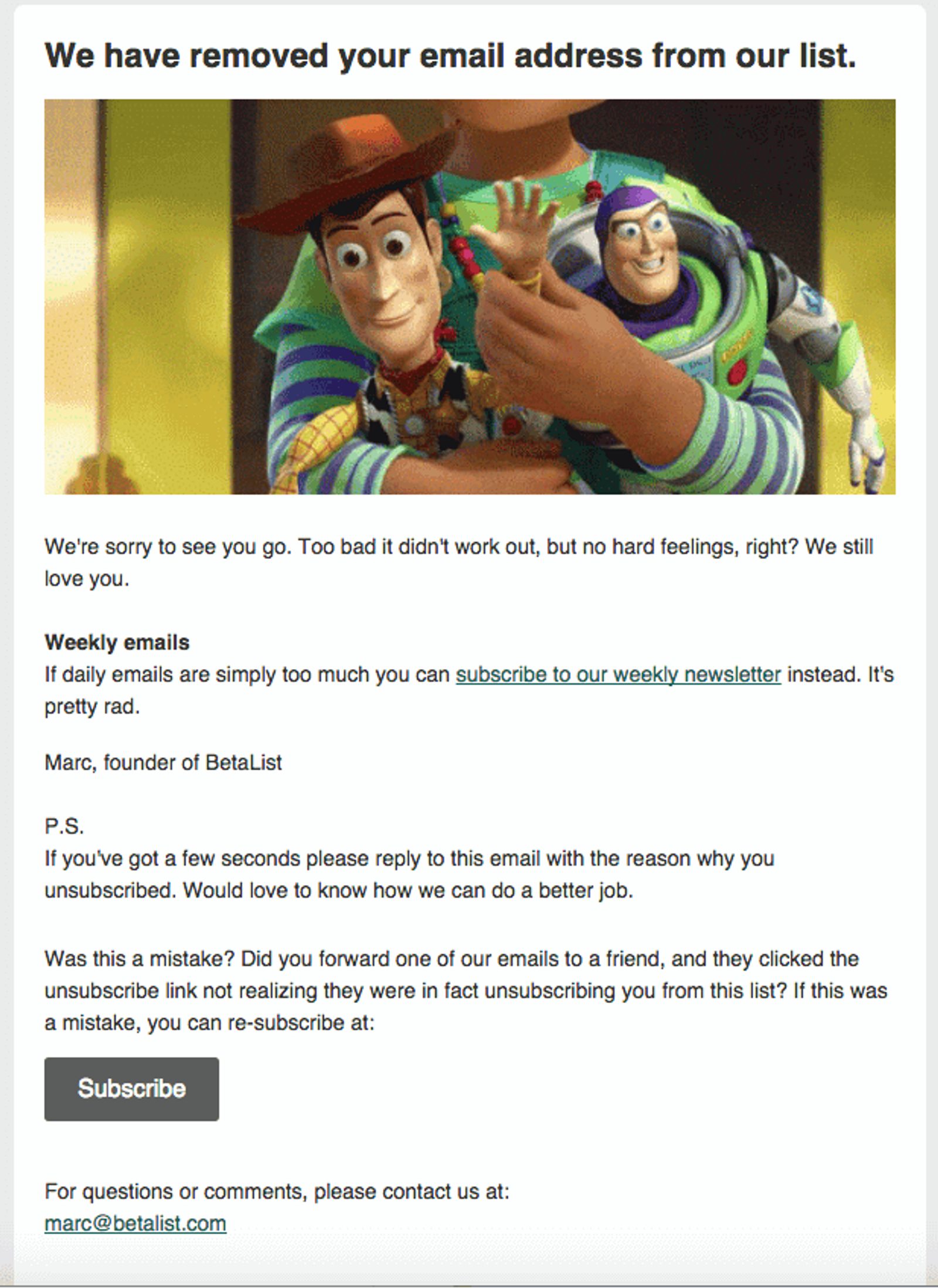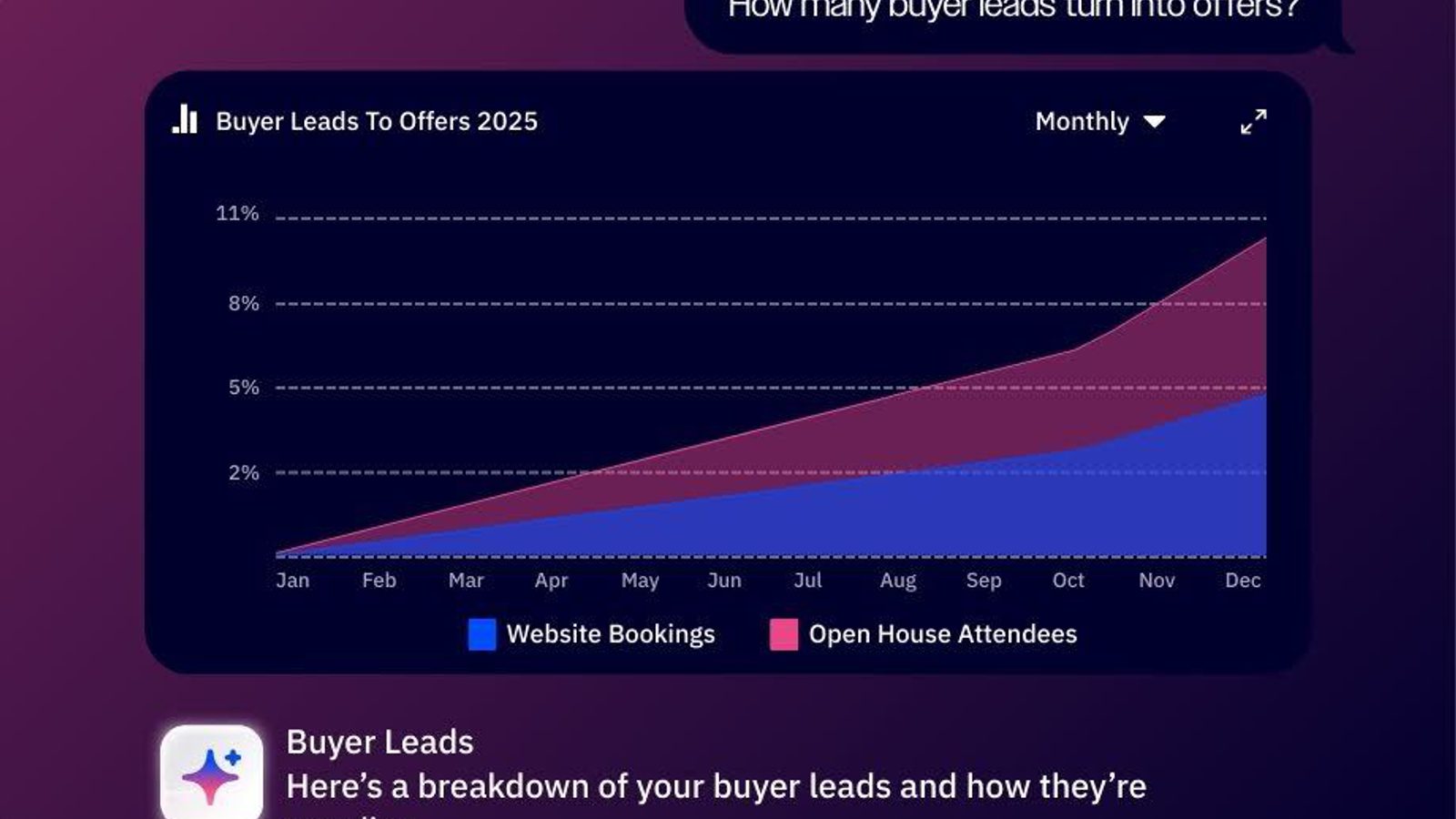“Subscribe, subscribe, subscribe, sub– wait...UNsubscribe?”
One of your email subscribers just unsubscribed from your email list.
Were you prepared for that?
If you weren’t, you’re not alone. You work hard to build your email list and get people to subscribe, so creating an unsubscribe message (and an unsubscribe process) may not be top of mind.
It’s not enough to just have a button that says “unsubscribe.” If all you have is a boring button or unsubscribe link, you’re just re-affirming the customer’s decision to leave.
“Whatever, I don’t care if you leave. Here’s the link."
Customer: Definitely not feeling the love here. Buh-bye.
Unsubscribes don’t have to be your downfall. In some cases, it’s just unengaged customers cleaning up your email list for you— and giving you a stronger, more engaged list.
If people aren't interested, you don't want them staying on your list anyway.
Two things to remember:
- Don’t freak out when someone unsubscribes. It’s a bummer, but you can’t please everyone. Some unsubscribes are inevitable, it is what it is.
- Don’t burn bridges! You should care about your unsubscribe message and overall process because any good experience you give your customer (even one that’s leaving) could bring them back if they remember you well.

Don’t worry. Unsubscribes aren’t the end of the world.
There are right ways to provide the options and create a mature, makes-them-think-twice unsubscribe message.
You’re about to learn:
- The top 3 reasons why people are leaving your email lists
- 7 tips for a better unsubscribe message – plus some examples of successful ones
- Mistakes you’re making with your unsubscribe message (and what to do instead)
Soon you’ll know the best ways to say goodbye (and still go on after).
Try it now, for free
7 ways to create a great unsubscribe message
Creating a good unsubscribe message is easier than you think. When you break it down, all the steps are actually pretty natural.
When you’re improving your unsubscribe email message, there are 7 ways to get people to stick around:
- Remind them of the good old days
- Stay on message
- Be yourself (don’t try to be a form)
- Show you care
- Offer alternatives
- Work on engagement
- Keep it simple
1. Remind them of the good old days
No one sees your email opt-in sign-up form and thinks, “Huh, that’s a really nice form, my email address would look so great on it.” Something got them to subscribe.
Your unsubscribe process should focus on what got them to subscribe in the first place.
And you should put it at every step of the process:
- Your unsubscribe page should make them second-guess their unsubscription
- Your unsubscribe confirmation should point them to where they can sign up again
- Your unsubscribe email (if you send one, which you might not want to) should do the same
Unsubscribe pages should be as easy to use as possible – you don't want to make it hard for people to unsubscribe, or they might stay subscribed and start marking your emails as spam.
But you can also use them as a way to get people who click unsubscribe to stick around.
2. Stay on message
Your unsubscribe page is not an opportunity to provide a long-winded description of why they shouldn’t leave you. That’s what your diary is for.
This is a chance to keep them interested. The goal is to keep them subscribed, not make them feel your abandonment. But– that doesn’t mean you shouldn’t target a little emotion.
1-800 Contacts weren’t afraid to target emotion, but they didn’t need a diary entry to do it.

What about Prague??
Did you go to Prague with 1-800 Contacts? Probably not. Neither did I, but even I had a moment reading this where I thought “Oh God, I’m awful. I mean, we had Prague!”
(And I’m not even subscribed to 1-800 Contacts. Also haven’t been to Prague).
1-800 Contacts knew how to target emotions with a simple and clear message that stayed on the point they were trying to make: “You’re leaving? Don’t!”
Not only that, but they gave an alternative to unsubscribing (something we’ll talk about in a bit).
A monologue belongs in your diary. A simple message belongs on your form.
3. Be yourself (Don’t try to be a form)
When you search for email marketing content, you’ll notice that a lot of blogs give similar advice: don’t talk like a robot. Your email opt-out wording should reflect your brand, just like any other copy.
If you are a fun company, have fun copy! Get creative with design, delivery method, and language.
A clean water non-profit, charity: water, did it with a splash that was very on-brand.
And guess what? Out of over 70,000 emails that were sent (likely with the help of a non-profit marketing automation tool), only 100 recipients unsubscribed and 740 recipients watched the video.
In other words, more people watched the video and stayed subscribed than people who unsubscribed. That’s an unsubscribe rate of just around .001%.
The last thing anyone wants is a form so boring and unengaging that they would rather watch a parking garage security camera feed. If you’re boring, they’ll never re-subscribe (or salvage their current subscription).
4. Show you care
Don’t burn bridges. Some people who unsubscribe won’t be a loss (if they were never engaging anyway), but you always want to give them the chance to return.
If you get seriously annoyed when you get a text reply that says “K,” you know what I’m talking about. Don’t act like you don’t care that they are leaving.

Potassium to you too, see ya never.
If they ever consider re-subscribing, you want to leave a good last impression. Don’t be careless about your unsubscribe message just because you don’t want them to leave.
5. Offer alternatives
Ever heard the phrase “It’s not over until it’s over” before?
Unsubscribes aren’t unsubscribed until the customer actually clicks “Unsubscribe.” There’s a lot you can do in that decision time, like offering alternative options to leaving. Some could be:
- Taking a break from emails for a set period of time
- Receiving different emails
- Provide other ways to keep in touch
- Offering an incentive to stay
Remember the 1-800 Contacts example from before? There was an opportunity to unsubscribe and take alternative action—like updating the email address or following on social media only.
People like choices.
It’s why restaurants have menus instead of a single meal. And why we have closets of clothes, not uniforms.
Take a look at how Grammarly does this.

I’ll have an order of Weekly Progress Reports with a side of Pop Quiz emails, please.
They offer to improve their experience by sending different emails and letting subscribers choose what they get, from blog content to progress reports.
How nice of them. Be nice like Grammarly.
6. Work on engagement
As I mentioned above, this unsubscribe doesn’t have to be a flat-out “See ya.” Make it “See ya soon.”
How do you do this? Make it memorable. Make it engaging. Make it personal.
This is an oldie but such a goodie. Groupon got a lot of attention for this unsubscribe video, featuring Derrick.
Let's watch what happens to Derrick when he sends an email to a subscriber that they didn’t like, prompting an unsubscribe click (about 15 seconds in).
An immediate closing screen reads “That was pretty mean… I hope you are happy. Want to make it up to Derrick? Resubscribe!”
I would feel bad for Derrick. I would also want to keep in touch with a company that makes me laugh that hard (sorry Derrick).
There are ways to work on engagement even when the clock is running down on the unsubscribe process. Get creative! Find your own Derrick! Your Derrick can help save your unsubscribe rate (and your Derrick) from certain doom.
7. Keep it simple
Always always always, this is a good rule of thumb.
Simplicity applies to language, content, and design. Yes, it’s good to be creative. Yes, it’s fine to offer an incentive to stay on the list. But there is such a thing as too much.
If they are unsubscribing from your list in the first place, it’s possible that it’s because they are already getting too much from you. Don’t have an unsubscribe process that is so in their face it only makes them run away faster.
Keep your language simple (because a downloadable glossary to decipher what the heck your unsubscribe copy is saying does not count as good content). A little goes a long way with copy, images, design, and the process.
Try it now, for free
How to manage email unsubscribes
If you use ActiveCampaign, there are a few different unsubscribe methods you can offer your contacts. For a deep dive into managing unsubscribes, you learn more here.
Here are the most popular ways to manage email unsubscribes:
- Include an unsubscribe link
- Use a custom contact field to track subscription preferences
- Create a subscription preference form
- Have automations that subscribe or unsubscribe contacts from your lists
The simplest (and legally safest) way to manage email subscriptions is to include an unsubscribe link. Most platforms (including ActiveCampaign) will set this up for you automatically.
But if you want to go a level deeper and let people unsubscribe from some communications but not others, it's worth looking into other ways to manage email unsubscribes.
Mistakes you’re making with your unsubscribe message (and what to do instead)
You’ve followed all of the tips, so your unsubscribes should be going down, right?
But what if your unsubscribe rate STILL isn’t decreasing (or if it’s even increasing)? It’s time to double-check.
These are the biggest mistakes you can make with your unsubscribe process:
- Hiding the unsubscribe link
- Making people log in to unsubscribe on your landing page
- Not sending an unsubscribe confirmation email
- Letting them leave without learning why
- Having a complicated, multi-step process, then making them wait
Hiding the unsubscribe link
Ok. Enough of this.
Nobody wants people to unsubscribe, but it’s not 100% avoidable, and hiding the button is not going to change that.
(Also, depending on where you are, it could be illegal. CAN-SPAM and GDPR have provisions related to how you can and can't email people).
I saw one such example of this in an email I received the morning I wrote this post:

A seemingly unfinished sentence is kind of a tip-off…
If people want to unsubscribe, they will find a way. In fact, trying to hide the link in a haze of beige might make them even more inclined to leave than they were originally.
If they can’t subscribe on their own, they might even send you a nasty email about it.
Just remember: Fewer people on your list who don’t want to be there means more time to engage those who DO want to be (which is more worth your time and money).
Don’t. Hide. The Unsubscribe Link.
Requiring a login to unsubscribe
After someone clicks unsubscribe from your email, they should be able to unsubscribe straight from your landing page.
Making them go all the way in just to leave again? Not cool, and not really necessary.
Think about this: a customer who is unsubscribing is probably someone who hasn’t engaged in a while anyway. If they’re anything like me, they probably don’t remember their login info (because they haven’t been engaging…).
Not only does this make the process longer and more annoying, but you also don’t stand to gain anything from it other than their frustration.
Not confirming unsubscribes
This is a personal pet peeve of mine. When you make a purchase, you expect a receipt, right? I also expect to be told that my unsubscribe request is confirmed.
(Note: You may not want to send people an unsubscribe people after they've just told you they want to leave your email list. Check the laws in your area).
Your unsubscribe page should have a confirmation message – to make sure people know they're done.
There was once a several weeks long period when I tried to unsubscribe from a publication I no longer read. I unsubscribed, and then still got it anyway.
Oh, also, I never got any indication of confirmation when I did it the first time (or either of the two times after that).
The only way I finally got rid of it (and finally got confirmation) was by speaking directly to their customer support, who informed me when it was done.

Such a time-saver.
A simple confirmation message to tell me (and the publication) that I was done with it would have saved us all a lot of time. A little reassurance goes a long way.
Letting them leave without learning why
You can’t know why someone is unsubscribing...or can you? You can, if you actually ask. People aren’t unwilling to share.
In fact, studies have been on this very subject by MarketingSherpa.

That’s a lot of reasons. How many did you think of?
Adding a survey to your unsubscribe page can provide valuable insight into the reasons why people are leaving your list. It will let you solve problems and prevent future customers from unsubscribing for the same reason.

The answer to all your Whys.
How will you fix a problem if you don’t know what the problem is? Find out what the problem is.
Making it complicated
Imagine being at the DMV. The arduous process of getting in line, waiting forever, and filling out 67 forms just to get a picture taken, or change the address on your license. And then wait around some more.
It sucks. Do you think a customer trying to unsubscribe wants to go through the same process? They don’t. Don’t make them.
Most people love a simple one-click unsubscribe process, but it’s not always that simple (and that’s ok). If you are getting survey answers or adding a little personality to your process, that won’t hurt you.
But what will hurt them is the pain of filling out a bunch of information that takes forever and then waiting 7-10 business days to process.

Imagine an ex sticking around for 7-10 days after a breakup...
Make this process as simple as possible, for everyone’s sake. Nobody wants to see a lot of unsubscribing. But remember—unengaged people leaving your list is a good thing. Your list will be less cluttered, it will be easier to see your engaged subscribers, and you email deliverability might even improve.
Knowing that makes it a lot easier to say goodbye (the right way).
What are you doing to make people unsubscribe?
It’s not you, it’s me. It’s a classic breakup line, but not likely one that you’ll be hearing from a customer who’s about to unsubscribe.
If a customer is unsubscribing, it’s not usually on a whim. But, you don’t always get to know the specific reason why.
Lucky for you, we know the 3 top reasons why customers unsubscribe from email lists.
- They’re getting irrelevant content
- You send too much
- They’re not interested anymore
You’re sending them irrelevant content
This is a big culprit of unsubscribes and a source of general annoyance with brands. Few things are more irritating than someone sending you things that you haven’t expressed interest in.
This is an email that I am constantly receiving from Amazon.

Sorry, Michael Anderle, still no.
Now normally, I welcome recommended product emails, but not when…
- I have never searched for this before
- I have never searched for anything related to this before
- I’ve never clicked through these emails to see this product, but they keep emailing me about it anyway
It’s super annoying. I love when Amazon recommends products based on my past orders, but this doesn’t accomplish that. Now I’m just spending time deleting emails with irrelevant content.
Be mindful of what content you send your customers. I’ve already unsubscribed from this kind of email, and I won’t be the last person to do so.
You send too much (it still does happen)
I love getting promotional emails. Most of the time. They give me an excuse to shop online for everything that I shouldn’t be spending my grocery money on. But as much fun as it is to be wooed into every sale imaginable, even I have limits.
Here’s the thing to remember – Sending a lot of emails is not always the kiss of death. BUT, if you’re sending a lot of emails, they have to be really good emails
Buffer sends emails nearly every day. Before you think that’s too much, take a closer look at this inbox. Notice anything?

No, it’s not the subject lines.
It’s that they’ve all been opened. If the emails are quality, daily emails might work.
Levi’s needs to work on this a little bit. Take a look.

Um, thanks Levi’s, but it’s actually you (not me)
LAST CHANCE 30% OFF on February 19th. And then again a week later on February 27.
That’s weird. Which is it?
Focus on what you send customers—not just how often. Confusion can be just as big a driver towards unsubscribes as an overflow of emails.
They just aren’t that into you anymore
It was really nice meeting you...
Yes, you have very special relationships with your customers. But so do plenty of other businesses, including your competitors. That means they are probably getting hundreds of emails a day from you (and all the rest of them).
Maybe they found a competitor with better emails. Or have become too advanced for the content you’re sending them.
Customers leaving your market is one of the four reasons why customers leave.
It’s ok. If someone leaves your target audience, don’t go sprinting after them. It’s a waste of time for you and annoying for them.
Nothing makes a person run screaming from email lists faster than a bunch of clingy unsubscribe messages.
And, in the interest of preventing people from running screaming from your email lists, we have the fix.
Conclusion: Why are unsubscribes good?
Unsubscribes can be helpful because they help your email deliverability. If people unsubscribe, they are less likely to mark you as spam (which would hurt your sender reputation). When people unsubscribe, it may also improve the email open rates and clickthrough rates of your future emails (because uninterested people are gone).
If people don't want to hear from you, it doesn't help you to have them on your email list. But you still want them to have a good experience — and a great unsubscribe message — on the way out!






